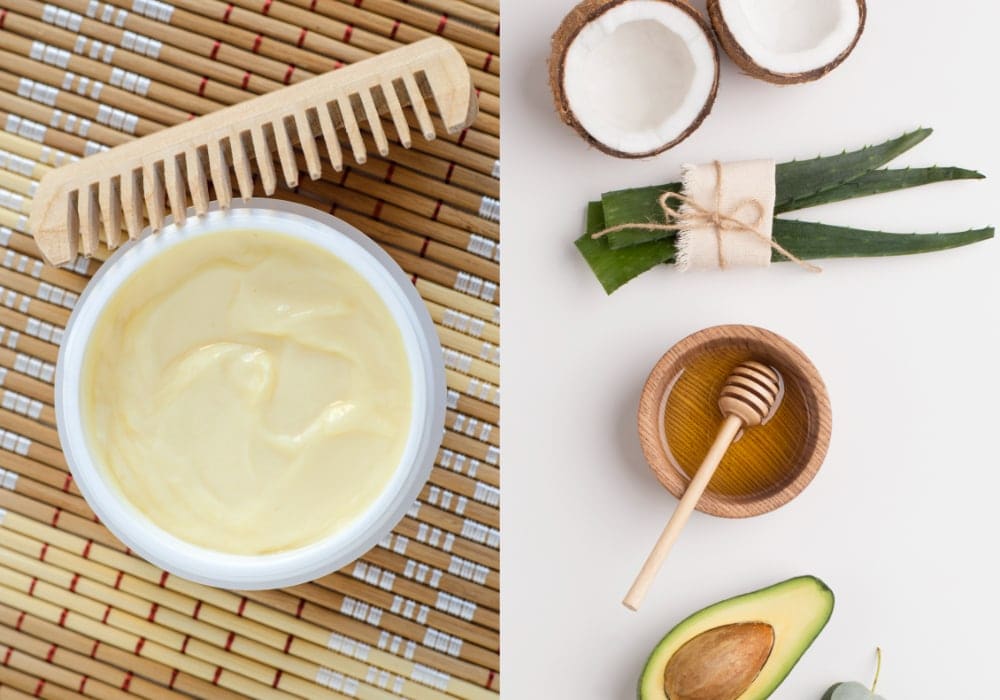Did you know it is possible to grow relaxed hair? Despite popular belief, relaxed hair can grow healthily and well.
While relaxing your hair is an intense chemical process, it does not mean your hair will no longer grow.
In this post, we’ll look at five relaxed hair care tips to give you strong and healthy hair growth.
What Is Relaxed Hair?

Relaxed hair is hair that has undergone a permanent straightening treatment using a chemical relaxer. Chemical relaxers are categorized as lye or no-lye relaxers.
- Lye relaxers often have sodium hydroxide, an alkaline chemical, in them. It works quickly, gently dissolving hair bonds to achieve a sleek, straight look. Lye relaxers are harsher on the scalp and require professional application to ensure no burning or overprocessing. They, however, leave hair softer and straighter with a sleek, shiny look.
- No-lye relaxers are typically calcium hydroxide, which is also an alkaline chemical. It is less basic than sodium hydroxide and works slowly to dissolve hair bonds. No-lye relaxers are gentle on the scalp but leave a calcium deposit on the hair. This can lead to dry, brittle, and lackluster hair, which is prone to breakage. Regular clarifying and using soft water can correct this.
Relaxing hair ensures straight hair without using heat. It is less of a time commitment than a natural hair journey.
You can wash, deep condition, and go through your entire hair routine, taking less than 30 minutes.
Relaxed hair also shows off the length of your hair, which can be hard for those with curly hair.
Growing relaxed hair can be challenging, especially without the right knowledge and tools.
People often think they can get lazy with their hair care after they relax their hair. That is not the case.
To maintain and grow hair that has received relaxation treatment, you must put in the effort. It is not easier to grow natural hair, but it does take less time.
How To Grow Relaxed Hair
Growing relaxed hair takes dedication and consistency with a proper hair care routine.
As your hair grows, you will have to manage two hair textures, which can be challenging. However, there are five steps you can take to help the process along.
Step 1: Give Your Hair Protein

Relaxers break the disulfide bonds of your hair to straighten it. This process breaks down the keratin in your hair.
Replenishing the protein lost after a relaxer is crucial since protein makes up 90% of your hair.
To replenish protein in your hair, opt for protein masks. How often you use a protein mask will depend on your hair porosity and diet.
Use protein cautiously, as protein overload is hard to correct. Always follow a protein treatment with a deep conditioner to restore protein-moisture balance in your hair.
Invest in a high-quality protein mask with hydrolyzed keratin, collagen, wheat, or egg protein.
You can also use the classic hair mayonnaise as a protein treatment. If you have money, go to a professional and let them decide what treatment to use and how often.
However, learning your own hair needs is beneficial to growing your relaxed hair.
You can also create hair treatments at home. Use egg and yogurt plus other fatty or hydrating ingredients like honey and avocado.
Coconut oil also contains protein and can help rebuild hair bonds. DIY protein masks are not as effective since the protein is not hydrolyzed for easy absorption.
Another detail to remember is that coconut oil is not ideal for low-porosity hair. It can build a film over the hair shaft, preventing it from absorbing moisture.
This can lead to coarse, dry hair. Avoid using clay cleanses, as they strip moisture and lead to dry, brittle hair.
Step 2: Wash Your Hair Weekly
Contrary to popular belief, dirty hair is not healthy hair. A clean scalp is key for growing hair.
A dirty scalp provides an ideal environment for bacteria and dandruff. Additionally, dirty hair cannot absorb moisture, as the oil and dirt in the hair will weigh it down.
To grow your relaxed hair, ensure you keep a clean and calm scalp. How often your wash your hair is up to you, but weekly washing is advisable.
Those who work out often or have sweaty or greasy jobs will benefit from washing more than others.
However, you should start by washing weekly to help your hair grow.
Washing your relaxed hair helps remove dirt, oils, and excess sebum from your scalp.
It also cleanses any product from your strands to prepare them to absorb moisture and nutrients from your treatment and conditioner.
Opt for hydrating, sulfate-free shampoos for regular hair washing. Use a clarifying shampoo or scalp scrub every four to six weeks to remove product buildup.
If you use a no-lye relaxer, you may want to clarify your hair more often. Focus the shampoo on your roots and scalp, and let it run down your ends while rinsing. This will ensure you don’t dry out your hair.
Step 3: Moisturize Daily

Previously relaxed hair is prone to dryness. Having your hair relaxed compromises your hair’s ability to hold on to moisture.
Because of this, processed hair requires more moisture than natural hair. To notice hair growth, you have to retain length. Moisturizing your relaxed hair daily will help.
Invest in a good, lightweight, protein-free moisturizer. You can use lotions, leave-in conditioners, or hydrating serums, but water should always be the first ingredient on the list.
Look for humectants like aloe vera, glycerin, urea, honey, propylene glycol, and hyaluronic acid to keep your hair healthy.
Avoid any moisturizers that include hydrolyzed keratin, collagen, rice water, hydrolyzed wheat protein, or egg.
Do not use protein-rich moisturizers every day, as this can lead to protein overload and breakage.
Keep your relaxed hair moisturized daily using these steps:
- Section your hair gently depending on length and thickness
- If your hair is very dry, spray a little water on the section. Do not saturate hair.
- Coat the section lightly with your moisturizer of choice
- Seal and retain moisture with a light oil like jojoba, grapeseed, or argan oil.
- Repeat for each section
Step 4: Minimize the Heat
Direct heat breaks down the hydrogen bonds of your hair. Heat can irreparably damage relaxed hair because it already has compromised bonds due to the relaxer chemicals.
A big part of growing relaxed hair is maintaining the length. Using too much direct heat will cause breakage and compromise your hair length.
To maintain hair length, avoid or limit applying direct heat to your hair. Opt for blow drying on cool, using a hooded dryer, or using other heatless styling tools like rollers, the scarf method, or tights.
Always use a heat protectant if you must use direct heat on your hair, and keep the temperature at 280°F to 350°F.
Step 5: Consider Your Diet

A major obstacle to growing relaxed hair is not eating well or staying hydrated. Your hair grows from your scalp and is nourished by what you put into your body. With an unhealthy diet, your hair suffers.
To grow your relaxed hair, focus on getting a nutrient-dense diet filled with whole foods.
Eat protein-dense foods and plenty of vegetables. Focus on dark, leafy greens, fish, lean meat, pulses, beans, and starchy carbohydrates like sweet potatoes.
You can supplement your diet with protein powder, Iron, Omega 3, Magnesium, and vitamins like biotin.
However, note that pure biotin supplements can cause breakouts in some. You can opt for B-complex vitamin supplements to get your biotin.
Be sure to get two to three liters of water daily and eat fruit.
Recommended For You:
How Long Do Relaxers Last on Natural Hair?
Conclusion
Relaxed hair is not easy to regrow into healthy, natural hair. You have to put in the effort to maintain its health and length. To grow previously relaxed hair, invest in good hydrating and strengthening products. Keep your scalp clean and don’t skip deep conditioning.
As hair grows, hydrate your new growth. Be gentle and avoid overmanipulating it. Touch up your new hair growth any time after eight weeks to avoid over-relaxing it. Stick to a regular moisturize and seal routine and don’t fear trimming dead ends. Remember to maintain a healthy diet and drink water for the best results on your relaxed hair journey.







This is just what I needed for my daughter’s hair. Trying to find a balance between care and time spent. Any quick tips for early mornings?
I am curious to find out what blog system you’re utilizing? I’m experiencing some minor security problems with my latest blog and I’d like to find something more secure. Do you have any recommendations?